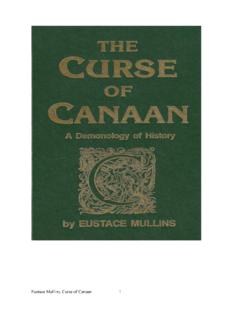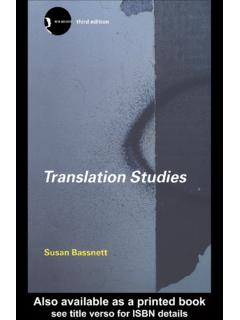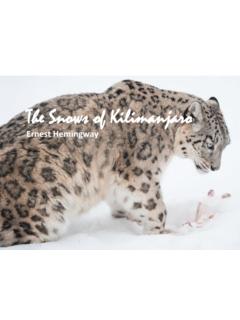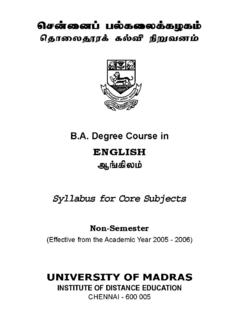Transcription of Scheme of work - filestore.aqa.org.uk
1 AQA Education (AQA) is a registered charity (number 1073334) and a company limited by guarantee registered in England and Wales (number 3644723). Our registered address is AQA, Devas Street, Manchester M15 6EX. Scheme of work A-level English Language and Literature 7707 Writing about society Introduction This is a Scheme of work for the teaching and learning of Writing about society. It is not prescriptive but offers suggested approaches for teaching around the topic, drawing upon key learning, concepts and analytical skills. In this part of the subject content, students should be encouraged to explore, through analysis and re-creative writing, how writers present narratorial point of view, characters, events, themes and genre through specific uses of language and through the conscious shaping of their narratives. Students should be able to build up a richly detailed understanding of how different aspects of texts are stylistically created.
2 They should be able to intervene in texts in experimental and targeted ways to explore and reveal the workings of texts. Students should also be taught how to construct comparative analytical commentaries reflecting on their re-creative writing. Students study one of four set texts chosen from: Into the Wild by Jon Krakauer The Suspicions of Mr Whicher: Or the Murder at Road Hill House by Kate Summerscale The Great Gatsby by F. Scott Fitzgerald The Kite Runner by Khaled Hosseini Key terms for this unit are: Society: a group of people working and living in a specific location who act out cultural beliefs and practices. Characterisation: the range of strategies that authors and readers use to build and develop characters. Point of view: the perspective(s) used in a text through which a version of reality is presented. Motif: a repeated concrete object, place or phrase that occurs in a work of fiction and is related to a particular theme.
3 Base text: the original text from which re-creative writing takes place. Assumed coverage Writing about society is an A-level topic and is not examined at AS level. If students are entering the A-level only, then this part of the subject content can be taught at any point. However, if students are entering for both the AS and A-level Writing about society should be taught in the second year. Covering this subject content in the second year also allows for AS and A-level students to be co-taught in the first year. It is assumed that approximately 9 weeks would be spent in the study of the text, comprising of about hours classroom contact per week. AQA Education (AQA) is a registered charity (number 1073334) and a company limited by guarantee registered in England and Wales (number 3644723). Our registered address is AQA, Devas Street, Manchester M15 6EX.
4 2 of 15 Scheme of work Writing about society Prior knowledge: understanding of levels of language analysis, some basic understanding of re-creative writing, and some basic ideas about narrative structure and point of view. Week 1 Learning objective Subject-specific skills Learning activities Differentiation and extension Resources Society Students will: understand the concept of society in relation to the individual, context, culture, family, community, power and place be able to talk about how the concept of society can be explored by authors in fiction. Applying knowledge of the following to their set text: different kinds of societal structures and social connections the influence of a reader s experience and expectations of particular societal structures and relationships on their interpretation of different portrayals of society. Ask students to bring in examples of literary and non-literary texts from their own reading which engage with issues to do with society.
5 Explore how different social groups and society more broadly are portrayed in these texts, and consider the contexts of the author and audience in relation to this portrayal. Refine the focus by asking the students to consider the same questions about society in relation to the set text. Students could research society to present a historical overview of the concept, looking at different kinds of societal structures in different eras and different places. Students could draw out a tree or web of the societal connections between the characters in their set text, and explore the nature of those connections (the branches , eg family kinship relationship, landlord/tenant relationship, business partnership, etc) extracts from texts (and/or those supplied by students) A3 paper to allow diagrammatic representation of societal connections in the set text AQA Education (AQA) is a registered charity (number 1073334) and a company limited by guarantee registered in England and Wales (number 3644723).
6 Our registered address is AQA, Devas Street, Manchester M15 6EX. 3 of 15 Week 2 Learning objective Subject-specific skills Learning activity Differentiation and extension Resources Beginning re-creative writing and commentary Students will: begin experimenting with re-creative writing begin reflecting on stylistic insights made available through re-creative writing. Applying knowledge of the following to their set text: the ways in which different themes can be foregrounded or backgrounded by different kinds of framing of texts how language choices create interpretative effects the degree of conscious consideration that can go into choices authors (and others) make in presenting a story. Compare some different kinds of re-creative acts, discussing the extent, nature and effect of that act. Examples could include editorial interventions in literary texts (eg Ezra Pound s interventions in T.)
7 S. Eliot s poetry, or Raymond Carver s editor s cutting and changing of his stories, authors own revised editions of their works); graffiti interventions into previous graffiti or street-signs, fanfiction, adaptation, etc. Explore epigraphs, and examine the ways in which these frame books and chapters, foregrounding particular themes. Experiment with adding epigraphs (quotes/extracts from other works, or invented quotes) to chapters of the set text, or changing or re-ordering those that are already there, and reflect on what the new epigraph does to the chapter (foregrounding, Students could find examples of epigraphs from different literary and non-literary works to create a bank of epigraphs of different kinds. Cut out and put in a bag. Each student could pick one or two in turn, add them to the beginning of their chosen chapter, and discuss the effects.
8 Students could collaboratively create a collection of re-created texts (including cross-media adaptations), and attempt to organise them according to different scales: how radical/subtle the intervention is, how enhancing/detracting/distorting, how legitimate and permitted/uninvited, etc. Student should justify their decisions. Students could design a new cover for their set text and compare this to the original in terms of the kinds of audience it might appeal to, what it suggests about the story contained a selection of examples of texts involving re-creative acts, including copies of drafts of literary texts showing editorial comments some children s books a collection of texts that use epigraphs (eg John Fowles The French Lieutenant s Woman) some secondary material on epigraphs (eg Gerard Genette s Paratexts) AQA Education (AQA) is a registered charity (number 1073334) and a company limited by guarantee registered in England and Wales (number 3644723).
9 Our registered address is AQA, Devas Street, Manchester M15 6EX. 4 of 15 backgrounding, tone-setting, etc). Working alone, each student chooses a paragraph from the set text and re-writes it in the genre of fiction for very young children. In pairs, students compare their re-written extracts, explaining the choices they made in terms of language, structure and tone, and reflect on the resulting differences in interpretative effects. within, etc. AQA Education (AQA) is a registered charity (number 1073334) and a company limited by guarantee registered in England and Wales (number 3644723). Our registered address is AQA, Devas Street, Manchester M15 6EX. 5 of 15 Week 3 Learning objective Subject-specific skills Learning activity Differentiation and extension Resources Character studies Students will: understand the ways in which characters are presented and developed through the process of characterisation develop their knowledge of key characters within their chosen text.
10 Applying knowledge of the following to their set text: ways of describing characters: physical appearance and body language, interaction, speech, opinions of other characters and the narrator the ways in which readers draw on schematic knowledge to flesh out descriptions and create vivid senses of characters the amount of focus afforded to individual characters at specific points in the novel. Explore a key character in the set novel by tracing their progression through the narrative, deciding on pivotal and key episodes in the characterisation of that character (these should include the first and last time these characters are mentioned). Choose one scene and compare how each of the characters involved (major and minor) is portrayed in that episode. Look at the language they use in expressing themselves (register, modality, verb processes, kinds of address, perceptual dimensions and deixis, etc), and the ways in which they interact with others (dominating, interrupting, supporting,) etc.















